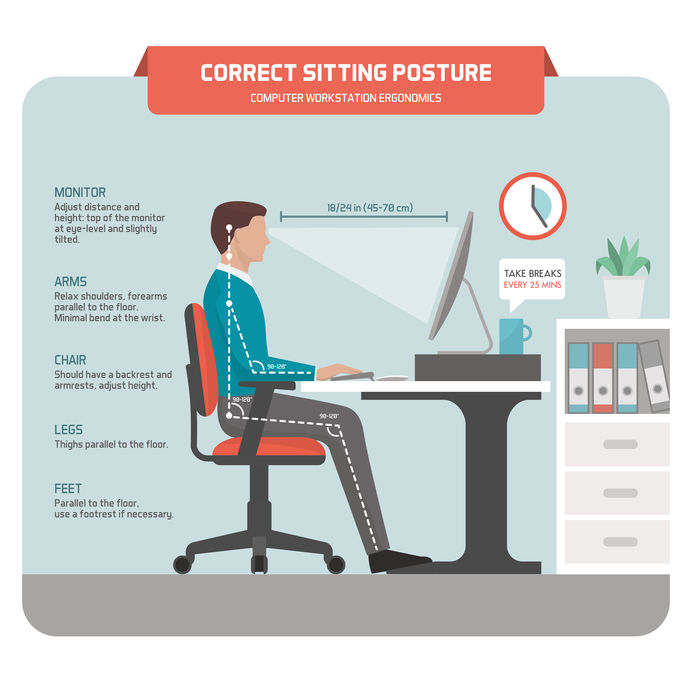NECK PAIN DURING THE PANDEMIC

Tid Bits of Info
- The natural curve of the cervical spine is shaped similar to a “reversed” C.
- The human head weighs between 10-15 lbs.
- Computer monitors should be located approximately at eye level.
- Positioning your upper arms against the ribs helps to reduce the stress on the upper back and neck muscles when working on a computer.
- Seek the advice and treatment of a Physical Therapist if you develop neck pain.
While working from home has been a growing trend in the country, it recently soared. Unfortunately, many people are using poorly designed workstations. The human body is not accustomed to sitting still and certainly not at a workstation that puts its skeleton in a position that places a tremendous amount of stress and strain on joints and soft tissues that are not prepared to handle it. Neck pain is one of the many physical responses we experience from poor posture and lack of movement.
When the body senses that there is too much abnormal stress and strain on a structure, it produces a pain signal in the attempt to make you move and relieve or reduce the amount of force on that particular structure. If you don’t move, you will definitely experience a gradual onset of discomfort followed by more acute, intense symptoms. The body is really good at protecting itself! If everyone listened to their pain, they would be able to reduce the long term effects that can take place in an environment that develops when they are not able to sit in a “good” postural position during an extended period of sitting.
The neck is especially prone to pain. Not maintaining proper neck and shoulder positioning can lead to the development of painful muscles and joints. Proper posture keeps the different forces that help hold body parts together at optimal levels. It also has a positive effect on the musculature of the body, enabling muscles to produce their maximal contraction force and making movement easy. There are 3 curves of the spine that must be maintained at all times if someone is going to have correct posture, and it must occur while they are standing, sitting, or lying down.

The lack of proper posture is the number one cause of neck pain in the workplace. The biggest culprit of neck pain development is assuming a position that forces you to look downward. Couple that with a position that forces your arms away from your ribs to reach the keyboard or mouse and you have effectively positioned your neck and shoulder muscles in a posture that it is unable to handle. Consequently, the muscles fatigue and cramp, which cause an irritant to the nervous system, and then a pain signal is sent to the brain. When the brain senses the problem, more signals are relayed to other parts of the neck and shoulder area which causes you to move. Movement is good. It stimulates blood flow and changes the amount of force that is being applied to one particular structure. The assumed posture during the use of mobile devices and many computers at ill-fitting work stations is rounded shoulder and forward head posture.
Most people who worked on computers during the pre-pandemic times developed “knots” in the big muscles in the shoulder that are adjacent to the ears. This muscle is called the Upper Trapezius and “knots or trigger points” are commonly found in it when someone is reports neck and shoulder pain. The cause of the “knots” is not entirely known in the healthcare world, but a popular theory is that there are a certain number of muscle cells (think of strands of spaghetti) that are placed under so much stress and strain that they are injured and “cramp.” The “knot” can be so dense that blood flow is restricted into it and this perpetuates more damage and more pain. The human head weighs approximately 10-15 pounds. When the cervical spine is flexed forward, the stress on the spine is “doubled” for every inch forward. Therefore, when someone is looking down at their computer or mobile device for a period of time, the muscles have to control a weight that can exceed 20 pounds.
Physical Therapists are some of the best healthcare professionals to help someone who presents with neck pain. The treatment for this condition always starts with a presentation of proper posture. The symptoms must be treated but the more important aspect of treatment is to educate the patient about the importance of maintaining strength and flexibility in the muscles that help to maintain proper posture. The person should seek medical attention to learn what proper exercises will help to resolve the acute symptoms and be able to build a foundation of strength that will help to alleviate their neck and upper back pain. Maintaining proper posture is the key to reducing neck pain.
























